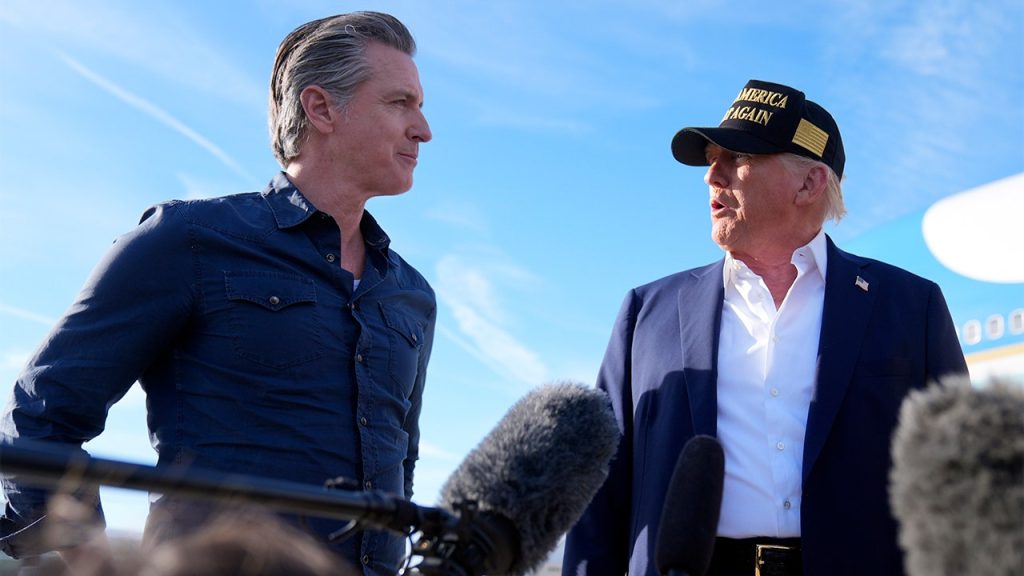California Governor Gavin Newsom’s visit to Washington D.C. marked a significant juncture in the ongoing dialogue between the state and the federal government regarding wildfire aid and resource management. The trip, occurring against a backdrop of political tension and policy disagreements, underscored the pressing need for collaborative solutions to address the devastating impact of wildfires on California’s landscape and communities. Newsom’s primary objective was to secure increased federal funding for wildfire recovery and prevention efforts, following a series of destructive fires that ravaged parts of Los Angeles and surrounding areas. The visit also served as a platform for Newsom to engage with President Trump and members of Congress, seeking to bridge the divide between state and federal perspectives on wildfire management.
The timing of Newsom’s visit was particularly noteworthy, occurring just one day after California lawmakers approved $25 million in legal funding to challenge the Trump administration on various policy fronts. This juxtaposition highlighted the complex and often contentious relationship between California and the federal government under the Trump presidency. Despite the underlying tensions, Newsom’s visit signaled a willingness to engage in direct dialogue and seek common ground on critical issues such as wildfire management and resource allocation. The meeting represented a potential turning point in the relationship, offering an opportunity to move beyond public sparring and towards constructive collaboration.
President Trump’s initial stance on wildfire aid to California had been marked by threats to withhold funding unless certain conditions were met, including changes to state water policy and voter identification requirements. However, following a personal visit to California to assess the wildfire damage firsthand, Trump appeared to soften his position and expressed a willingness to work with Governor Newsom. This shift in tone suggested a potential thawing of relations between the two leaders, creating an opening for productive discussions and potential compromise on key issues.
Newsom and Trump’s personal interactions, while often cordial in face-to-face meetings, have been contrasted by frequent public criticisms and disagreements aired on social media platforms. This dichotomy underscored the complex dynamics of their relationship, characterized by a mix of personal rapport and policy clashes. Despite their differing political ideologies and approaches to governance, both leaders recognized the shared imperative of addressing the devastating impact of wildfires on California’s environment and communities. Newsom’s visit provided an opportunity to navigate these complexities and seek common ground for the benefit of the state.
President Trump has consistently attributed a significant portion of the blame for California’s wildfires to Governor Newsom, Los Angeles Mayor Karen Bass, and state legislative policies. He has criticized the state’s land and water management practices, characterizing them as “disastrous” and contributing factors to the severity of the wildfires. In an executive order issued in response to the fires, Trump emphasized the national interest in ensuring California’s preparedness for wildfire prevention and response, while simultaneously highlighting his concerns about state policies. This executive order reflected the President’s assertion of federal authority in addressing the wildfire crisis, while also underscoring his critique of California’s approach to land and water management.
Newsom’s visit to Washington D.C., while brief, held significant symbolic weight, representing a crucial step towards fostering collaboration between California and the federal government on the critical issue of wildfire management. The trip provided a platform for direct dialogue between Governor Newsom and President Trump, offering an opportunity to bridge political divides and seek common ground for the benefit of California’s communities and environment. The outcome of these discussions could have far-reaching implications for the state’s ability to effectively address the ongoing threat of wildfires and build resilience against future disasters. The visit, despite occurring amidst ongoing political tensions, held the potential to forge a more constructive path forward in the relationship between California and the federal government.

